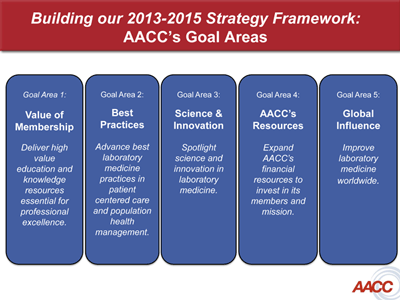Change has been a constant in the healthcare industry, but with transformational events occurring during the past several years not only in healthcare delivery and financing but also the worldwide economy and workforce, the AACC Board of Directors in 2012 embarked on a strategic planning process to guide the organization in anticipating, responding to, and thriving in an uncertain future. The 10-month process, which culminated with the board's endorsement of a strategic plan at its December 2012 meeting, sets the path for AACC over the next 3 years, 2013–2015.
The plan reaffirms AACC's vision—better health and healthcare through laboratory medicine—and its mission of providing global leadership in advancing the practice and profession of clinical laboratory science and medicine. The association's strategic direction will be focused on the following: value of membership; best practices; science and innovation; global influence; and AACC's resources, the latter to ensure that the organization remains vibrant and continues to provide top-notch service for members.
Ambitious and proactive, the planning process came at a crucial time in the association's history, according to AACC's 2012 president Greg Miller, PhD, DABCC, FACB. "Times of change are also times of opportunity. The 2013–2015 priorities represent a high impact plan that builds on AACC's many contributions over its 65-year history. I commend the 2012 Board of Directors, our staff, and all who participated in developing this plan. Our focused strategic objectives will produce real benefits in the coming years for members, the in vitro diagnostics industry, and the public we serve."

The journey to the plan started in March 2012 with broad input from key stakeholders and thought leaders, including not only the board but also AACC's staff, its members, and representatives from other associations, organizations, and the in vitro diagnostics industry. These conversations pinpointed 15 high-level trends that will shape the next decade for the field of laboratory medicine. Some examples are that patients will want and need to know more about their own clinical laboratory findings, that scientific developments are enabling greater specialization in testing which requires new expertise for clinical chemists, and that younger members expect different things from their association experience and have more alternative resources to tap.
With the backdrop of key trends, the board considered the likelihood of plausible futures in healthcare delivery and payment reform and advances in clinical chemistry and lab medicine, ranging from incremental changes with modest consequences to transformational changes with substantial impact in both areas. This enabled the board to identify the association's value to stakeholders in any future scenario.
From here, the board set 19 strategic priorities that fall under the five broad areas of focus. The AACC staff already has begun the challenging work of implementing these priorities, some of which include increasing ways for members to access knowledge, resources, and peer-to-peer networking; developing pilot programs and programming to empower laboratorians to contribute more directly to patient care; and leading and coordinating international harmonization of clinical laboratory testing procedures.
AACC's 2013 president, Robert Christenson, PhD, DABCC, FACB, emphasized that the document's strength is in enabling the association to adapt flexibly to a dynamic environment as well as ongoing input from its membership. "The Board of Directors is excited about AACC's direction and we ask our members to participate with us by volunteering, sharing what they're learning, and being active innovators in their own work. This is an important time for all of us to effect change in our healthcare system and to advance AACC's important mission and vision."